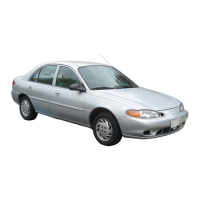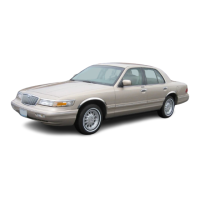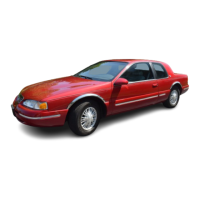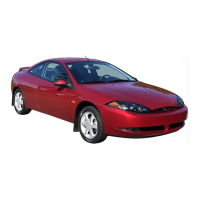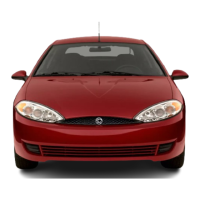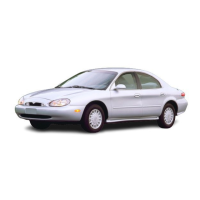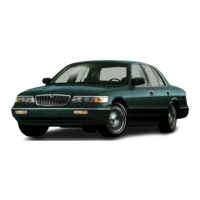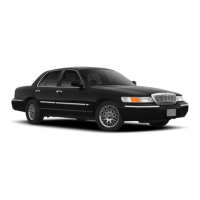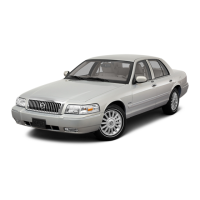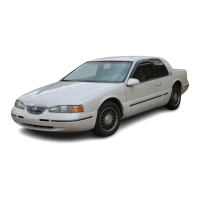
 Loading...
Loading...
Do you have a question about the Mercury 1997 Cougar and is the answer not in the manual?
| Brand | Mercury |
|---|---|
| Model | 1997 Cougar |
| Category | Automobile |
| Language | English |
Details Ford Motor Company's commitment to excellence in products and services.
Outlines the core principles that guide Ford's operations and customer interactions.
Provides essential information and notes on how to effectively use the owner's guide.
Explains the different types of warranties covering your vehicle and basic rights.
Details the Ford Extended Service Plan for additional vehicle protection.
Advises on proper braking techniques for new brake linings during the break-in period.
Specifies the correct engine oil to use and warns against special break-in oils.
Describes the warning lights and gauges on the vehicle's mechanical instrument cluster.
Explains the function and meaning of the brake system warning light.
Details the ABS warning light, its behavior, and what it indicates.
Describes the warning light and chime that remind occupants to fasten their safety belts.
Explains the air bag readiness light and its function in indicating system status.
Informs about the low coolant warning light and checks required.
Indicates a problem with the battery charging system and the need for electrical check.
Explains the overdrive off indicator light and its function.
Describes the traction assist off indicator light and when it illuminates.
Explains the high beam indicator light and when it illuminates.
Indicates when the engine's emission control system requires service.
Details the anti-theft alarm light and its function, if equipped.
Explains the turn signal indicator lights that show direction of turning.
Indicates when the cruise control system is actively maintaining set speed.
Alerts when any door is not completely shut, glowing when the key is in the ON position.
Indicates engine oil pressure status and potential severe engine damage.
Comes on when the fuel gauge indicates approximately 1/8 to 1/16 of a tank.
Indicates low washer fluid level when windshield washers are activated.
Displays the approximate amount of fuel in the tank when the ignition is ON.
Indicates the engine coolant temperature, warning of overheating.
Shows the vehicle's speed in miles or kilometers per hour.
Records the total number of miles or kilometers the vehicle has been driven.
Tracks mileage up to 999.9 miles or kilometers for specific trips.
Displays approximate engine revolutions per minute (rpm) indicating engine speed.
Details on using the controls for the radio and CD player.
Explains methods for tuning radio stations using buttons like SCAN/TUNE and SEEK.
Describes how to use the automatic memory load feature to set radio stations.
Guidance on adjusting bass, treble, balance, and fader for optimal audio.
Instructions for inserting discs, beginning play, changing tracks, and using features.
Instructions on turning the radio on/off and adjusting the volume.
Explains methods for tuning radio stations using AMS, SEEK, and SCAN functions.
Guide to setting station memory preset buttons for AM and FM stations.
Guidance on adjusting bass, treble, balance, and fader for optimal audio.
Instructions for inserting tapes, locating tracks, and using fast forward/rewind.
Details on using the Dolby B noise reduction feature for improved audio quality.
Provides tips on maintaining the cassette player and tapes for optimal performance.
Instructions on turning the radio on/off and adjusting the volume.
Explains methods for tuning radio stations using TUNE, SEEK, and SCAN functions.
Guide to setting station memory preset buttons for AM and FM stations.
Describes how to use the automatic memory load feature to set radio stations.
Guidance on adjusting bass, treble, balance, and fader for optimal audio.
Explains how distance and signal strength affect FM reception quality.
Describes how terrain features can impact FM signal clarity and introduce noise.
Provides information on allowable AM and FM radio frequencies.
Details warranty coverage and service recommendations for the audio system.
Introduces the manual and semi-automatic climate control systems.
Explains operation of the manual system for heating, defrosting, and cooling.
Describes the SATC system's characteristics and automatic comfort control.
Details how to adjust airflow direction and volume from instrument panel registers.
Explains the DRL system operation, specific to Canadian vehicles.
Guides on operating the rotary control for headlamps and parking lamps.
Instructions for setting the automatic headlamp system.
Details manual operation of interior lighting and instrument panel dimming.
Explains the functions of ACC, LOCK, OFF, and START ignition key positions.
Procedure for safely removing the ignition key.
Describes the functions of the turn signal lever for signals, high beams, and wipers.
Instructions for activating and deactivating the speed control system.
Guides on how to set the desired speed using SET ACCEL.
Explains how to adjust the set speed up or down using COAST and SET ACCEL.
Details on disengaging speed control and returning to a set speed with RESUME.
Information on operating the map lamps for driver and passenger.
Explains how to operate the moon roof using the rocker control.
Details the express open feature for the moon roof.
Describes how to open and close the sliding shade for sun protection.
Explains the electronic day/night mirror function and how to operate it.
Instructions for turning on the visor mirror light.
Describes the right side view mirror and its wider field of vision.
Details the controls for locking and unlocking doors and manual override functions.
Explains how interior lights turn on with door handle or remote entry activation.
Guides on using power window controls on each door and the master panel.
Describes how the system protects the vehicle against break-ins and triggers.
Step-by-step instructions for arming the anti-theft system.
Provides methods for disarming the system (triggered or untriggered).
Details the remote entry system for locking, unlocking, and trunk access.
Explains proper positioning of head restraints for maximum protection.
Guides on moving seats forward/backward and reclining manual seats.
Details seatback recline operation and safety features.
Instructions for adjusting power seats in multiple directions.
Describes controls for sport seats, including lumbar support and bolsters.
Explains rear seat access and important safety belt usage guidelines.
Details how combination lap and shoulder belts adjust and lock.
Explains vehicle-sensitive and automatic locking modes for retractors.
Describes locking cinch tongues for rear outboard seating positions.
Instructions for adjusting and fastening lap belts in rear center seats.
Information on obtaining and using safety belt extension assemblies.
Recommendations for periodically checking safety belt systems for proper function.
Important precautions and information regarding the air bag system.
Safety advice regarding children, air bags, and proper restraint usage.
Legal requirements and guidelines for using child safety restraints.
Procedures for installing child safety seats in front and rear seating positions.
Key considerations for starting a fuel-injected engine without using the accelerator.
Steps to take before starting the engine, including safety checks.
Detailed steps for starting the engine, including cold and warm engine procedures.
Recommendations for using an engine block heater in cold climates.
Precautions to avoid dangerous effects of exhaust fumes.
Explains how to apply brakes, including non-ABS and ABS systems.
Details on how to set and release the parking brake.
Information on the Traction-Lok axle and its impact on traction.
Explains the Traction Assist system for improving tire traction and preventing wheel spin.
Information on power steering and how to steer the vehicle.
Details on operating the automatic overdrive transmission.
Procedure for shifting the transmission out of Park.
Guidelines on weight limits (GVWR, GAWR) and load distribution.
Essential precautions for safely towing a trailer with your vehicle.
Advice for driving cautiously on slippery roads and in high water conditions.
Explains the function and duration of hazard flashers.
Information on vehicle electrical protection devices and their locations.
Details the fuses, circuit breakers, and relays in the instrument panel.
Explains high current fuses, their location, and replacement recommendations.
Step-by-step guide on how to check and replace fuses.
Information on checking and replacing circuit breakers.
Troubleshooting steps for when the engine cranks but does not start.
Procedure for safely changing a flat tire.
Guidelines and precautions for using the temporary spare tire.
Instructions for locating and removing the spare tire.
Steps to prepare the vehicle for safe tire changing.
Detailed steps for removing the flat tire and installing the spare.
Instructions for removing and replacing aluminum road wheel ornaments.
Procedure for removing and replacing the center wheel cover.
Information on anti-theft lug nuts and their special key.
Instructions for safely jump-starting a vehicle with a booster battery.
Recommendations for professional towing services and equipment.
Ford's goals for making vehicle servicing easy and accessible.
General safety precautions to follow when performing vehicle maintenance.
Procedure for safely opening the vehicle's hood.
Diagrams showing engine types and locations of service items.
Specifies recommended engine oil types, viscosity, and API certification.
Step-by-step guide on checking and adding engine oil using the dipstick.
Guidance on engine oil and filter change intervals based on mileage or time.
Information on brake fluid level checks and required fluid types.
Instructions for checking and maintaining windshield washer fluid levels.
Guidance on checking engine coolant levels and protection properties.
Safe procedures for adding engine coolant, including precautions.
Instructions for checking and adding power steering fluid.
Guidance on checking automatic transmission fluid levels.
Information on checking and maintaining the vehicle's battery.
Tips for cleaning and replacing windshield wiper blades.
Guidance on checking tire pressure and performing tire rotation.
Instructions on when and how to replace vehicle tires.
Explanation of Tire Quality Grades (Treadwear, Traction, Temperature).
Advice on using snow tires and chains in winter conditions.
Procedure for safely filling the fuel tank.
Guidelines on selecting the correct type of fuel for the vehicle.
Ensuring proper function of the catalytic converter and emission control parts.
Details on the 24-hour roadside assistance program and covered services.
Information on how to contact roadside assistance and reimbursement procedures.
Guidance on addressing service or maintenance issues with dealers.
Information on the Dispute Settlement Board (U.S. Only) for warranty disputes.
Contact information and program details for Canadian customers.
Advice for vehicle owners exporting or importing vehicles internationally.
Lists Ford-approved products for cleaning and protecting the vehicle.
Overview of accessories categorized for travel, comfort, and appearance.
Details on engine types, fuel capacity, tire size, and fluid capacities.
Provides specifications for various fluids including brake fluid and engine oil.
